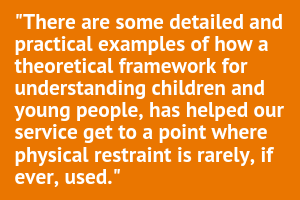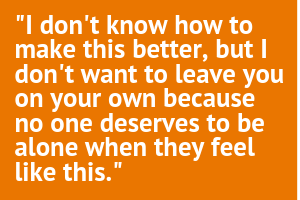Can theory be an ally in efforts to reduce physical restraint?
Erica Barr is a House Leader with South Ayrshire Council. Here she discusses the need to link theory with practice to improve our understanding of children and young people.
Over the course of the last 10 years, there has been a growing understanding of the complexity of the residential child care endeavour. This has underpinned attempts to reframe residential child care as an intellectual endeavour requiring a qualified workforce with a university degree. In spite of this, the relationship between practice, and theories around what constitutes effective practice, continues to be fragmented with some practitioners viewing the move towards a professionalised workforce with apprehension, suspicion, and scepticism. This is not to say that current practice does not use theory at all; knowledge gained from courses such as the HNC Social Care, and on-going training, will undoubtedly be identifiable in the practice of many residential child care practitioners.
Without support, however, this knowledge often remains largely tacit, learned implicitly as practitioners develop in their role. This struggle to take what is tacit and make it explicit means that practitioners in residential child care can find it difficult to articulate what they do and why they do it, undermining their sense of professional identity, and voice within multi-disciplinary contexts. This can also undermine their ability to utilise theory effectively and consciously in their everyday engagement with young people.

There are some detailed and practical examples of how a theoretical framework for understanding children and young people has helped our service get to a point where physical restraint is rarely, if ever, used. It's important to note too, however, that successful implementation of any framework also depends on a number of factors. These include: effective leadership; a clear vision; on-going support for practitioners to integrate theory into practice; and the creation of reflective spaces for practitioners to be able to identify, articulate and manage the impact of our emotions on our capacity to be available, attuned and responsive to young people in pain. For me, the ability to utilise theory effectively, not only enables me to support young people, it also allows me as a manager to help develop in others, the capacity to do likewise.
A threshold moment
This takes me to my example of theory in action. For those of you who know me, or have been part of any training that I have delivered, it is this episode in my residential child care journey that I refer to as my light-bulb moment. A moment when theory and practice come together in such an explosive way that it transforms your practice so fundamentally and you cannot go back to previous ways of knowing, being and responding to young people. Laura Steckley would describe this as a threshold moment for me.
Back in 2014, I was employed as a residential worker, and we were supporting a young boy, let's call him Sam, aged 13, who quite often displayed what was then understood as 'challenging behaviour'. It was common practice within the house that when he 'kicked off', he would be taken to his room for 'time-out'. I was in my first year of the MSc Advanced Residential Child Care, a course that opened up to me a whole world of theory about residential child care, that I didn't even know existed. Add to this an inquisitive mind, and an innate need to understand the 'Why' of things, and you can understand why I felt like one of the characters in Plato's Allegory of the Cave.
Time in, not time out
One day whilst Sam was being taken to his room by carers for 'time-out', he attacked the carers when they turned to leave, leading to him being held in a restraint. The sense that the care team made of this emotive situation was that Sam was very calculated: he had waited until the carers had turned their back on him and then attacked. Framing Sam's response in such a way was problematic because it contributed to a narrative of him as dangerous and calculated, and it shaped the team's thinking about how we should respond to him. As I was thinking about my own learning in relation to attachment, I wondered to myself if Sam's behaviour could, in any way, have been driven unconsciously by a fear of being left alone in an emotional state, because, after all, many young people who experience difficulties with their emotions find themselves unable to self-regulate. I wondered if Sam knew, even subconsciously, that by attacking the carers this would result in a physical restraint, meaning that he would not be left alone with no means or effective strategy to manage or reduce his current distress.
Driven by curiosity, and real desire to make things better for Sam, I was determined to explore these ideas further, by ensuring that should Sam 'kick off' again, I would attempt to give him time-in, not time-out. By time-in, I mean that I would attempt to stay with him and offer support, rather than leave him to cope with his feelings on his own. So, I did just that. The next time I was on shift and he was distressed, rather than removing him to his room, I stayed with him in the lounge whilst he kicked furniture, swore like a trooper, and ranted about how he hated his life and everyone in it. I remember saying to him at that point, "I don't know what to do for you right now pal, I don't know how to make this better, but I don't want to leave you on your own because no one deserves to be alone when they feel like this". Over the course of the next 20 minutes or so, he calmed down, spoke about how difficult it was to constantly be transitioning between the Children's House and his family home, and how he just wanted to go home to his mum. He broke down in floods of tears. This reinforced for me what I already suspected: kids in distress need time-in, not time-out! It also reinforced for me, and for Sam, that he could be emotionally held and contained during times like this, through the use of a therapeutic relationship, and a willingness and ability on the part of the adult to hang-in there when it gets tough.
A curiosity about the behaviour of young people
Since this experience, I have built on this theory of my own on attachment and time-out, undertaking a small piece of qualitative research which similarly identified a relationship between time-out and physical restraint. In this study, all young people and some carers identified how young people's refusal to undertake time-out (identified in the study as a practice whereby young people were asked to sit alone for a pre-determined period of reflective time), could lead to young people being restrained.
This has highlighted for me how important theory is in our practice, and how crucial it is that we, as practitioners, take the time to be curious about what young people's behaviour is communicating to us. How we support young people in crisis, and how we respond to the pain that often lies beneath many of the behaviours that we as practitioners find most challenging, is fundamental to reducing the use of physical restraint in our houses. Having a strong theoretical understanding to support our assessment and understanding of the situations we respond to is crucial in that endeavour.
Update | September 2021
Erica Barr is now a Service Manager for Glasgow City Health and Social Care Partnership. Here she reflects two years on from the original blog post.
The following video was recorded as part of SIRCC 2021 Online.
Read other blog posts in this series
The views expressed in this blog post are those of the author/s and may not represent the views or opinions of CELCIS or our funders.
Commenting on the blog posts
Sharing comments and perspectives prompted by the posts on this blog are welcome. CELCIS operates a moderation process so your comment will not go live straight away.



